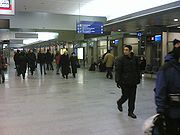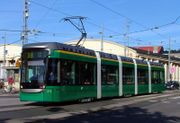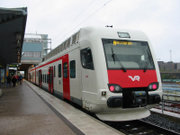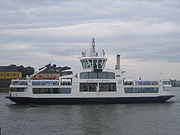
Public transport in Helsinki
Encyclopedia

Bus
A bus is a road vehicle designed to carry passengers. Buses can have a capacity as high as 300 passengers. The most common type of bus is the single-decker bus, with larger loads carried by double-decker buses and articulated buses, and smaller loads carried by midibuses and minibuses; coaches are...
, tram
Tram
A tram is a passenger rail vehicle which runs on tracks along public urban streets and also sometimes on separate rights of way. It may also run between cities and/or towns , and/or partially grade separated even in the cities...
, metro
Rapid transit
A rapid transit, underground, subway, elevated railway, metro or metropolitan railway system is an electric passenger railway in an urban area with a high capacity and frequency, and grade separation from other traffic. Rapid transit systems are typically located either in underground tunnels or on...
, train
Train
A train is a connected series of vehicles for rail transport that move along a track to transport cargo or passengers from one place to another place. The track usually consists of two rails, but might also be a monorail or maglev guideway.Propulsion for the train is provided by a separate...
, and ferry
Ferry
A ferry is a form of transportation, usually a boat, but sometimes a ship, used to carry primarily passengers, and sometimes vehicles and cargo as well, across a body of water. Most ferries operate on regular, frequent, return services...
services. The system is managed by Helsinki Region Transport (HRT).
The diverse public transport system of Helsinki region consists of trams
Helsinki tram
The Helsinki tram network forms part of the Helsinki public transport system organised by Helsinki Regional Transport Authority and operated by Helsinki City Transport in the Finnish capital city of Helsinki. The trams are the main means of transport in the city centre. 56.6 million trips were made...
, suburban metro railways, the subway
Helsinki Metro
The Helsinki Metro , is the metro system in Helsinki, Finland. It is the World's most northern metro system, and currently the only one in Finland. The system was opened to the general public on 2 August 1982 after 27 years of planning...
, bus lines and two ferry
Ferry
A ferry is a form of transportation, usually a boat, but sometimes a ship, used to carry primarily passengers, and sometimes vehicles and cargo as well, across a body of water. Most ferries operate on regular, frequent, return services...
lines.
Today, Helsinki (Helsingfors) is the only city in Finland to have access to trams or subway trains. There used to be two other cities in Finland with trams: Turku
Turku
Turku is a city situated on the southwest coast of Finland at the mouth of the Aura River. It is located in the region of Finland Proper. It is believed that Turku came into existence during the end of the 13th century which makes it the oldest city in Finland...
(Åbo) and Viipuri (Vyborg). However, Turku abandoned trams in 1972 and Viipuri (at that time already part of the USSR) abandoned them in 1957.
The Helsinki Metro
Helsinki Metro
The Helsinki Metro , is the metro system in Helsinki, Finland. It is the World's most northern metro system, and currently the only one in Finland. The system was opened to the general public on 2 August 1982 after 27 years of planning...
, opened in 1982, was the first, and so far the only, subway-system in all of Finland. For the first 16 years of its existence, the line was topologically
Topology
Topology is a major area of mathematics concerned with properties that are preserved under continuous deformations of objects, such as deformations that involve stretching, but no tearing or gluing...
only one straight line, but in 1998 a fork with three stations each was added at the eastern end of the line.
In 2006 the construction of the long debated extension of the subway system west into southern parts of Espoo
Espoo
Espoo is the second largest city and municipality in Finland. The population of the city of Espoo is . It is part of the Helsinki Metropolitan Area along with the cities of Helsinki, Vantaa, and Kauniainen. Espoo shares its eastern border with Helsinki and Vantaa, while enclosing Kauniainen....
(Esbo) was approved in Espoo City Council, and serious debate about an eastern extension into Sipoo
Sipoo
Sipoo is a municipality of Finland. Its seat is in Nikkilä/Nickby.It is the eastern neighbour of Helsinki and is located in the Uusimaa region. The municipality has a population of and covers an area of ofwhich is water...
(Sibbo) has taken place. To cope with the rising usage the Helsinki Metro is also planned to be further automated by 2014, replacing the old traffic control system with a newer one to allow shorter train intervals, although with shorter trains.
Trains depart from the Central Railway Station and Pasila
Pasila
is a suburb in Helsinki, Finland. It is a central-northern neighbourhood, bordering Alppila to the south, Central Park to the west and Vallila to the east....
(Böle) station to destinations across Finland. Pendolinos offer higher speed (up to 220 km/h) connections to major cities, as do Intercity and Intercity2 trains at slightly slower speeds, and regional and suburban trains cover all of the capital region and smaller cities and towns as far north as Riihimäki
Riihimäki
Riihimäki is a town and municipality in the south of Finland, about north of Helsinki and southeast of Tampere. It is somewhat of a railway junction, since the railway tracks going from different parts of the nation to Helsinki merge there. Sako, Ltd...
and Lahti
Lahti
Lahti is a city and municipality in Finland.Lahti is the capital of the Päijänne Tavastia region. It is situated on a bay at the southern end of lake Vesijärvi about north-east of the capital Helsinki...
, and as far west as Karis
Karis
Karis is a former Finnish town and Finnish municipality in Finland. On January 1, 2009, it was consolidated with Ekenäs and Pohja that formed the new town of Raseborg....
(Karjaa). A tunnel
Helsinki to Tallinn Tunnel
thumb|250px|A tunnel from Helsinki to Tallinn would connect to [[Rail Baltica]].The Helsinki to Tallinn Tunnel is a proposed undersea tunnel that would span the Gulf of Finland and connect the Finnish and Estonian capitals....
has been proposed to connect Helsinki with Tallinn, though the proposal is still in the investigation phase. Ring Rail Line (Kehärata-Ringbanan), a project to connect Helsinki-Vantaa Airport
Helsinki-Vantaa Airport
Helsinki Airport or Helsinki-Vantaa Airport is the main international airport of the Helsinki metropolitan region and the whole of Finland. It is located in Vantaa, Finland, about west of Tikkurila, the centre of Vantaa, and north of Helsinki city centre...
with the national rail network and downtown Helsinki, has been approved and construction should be completed by 2013.
Helsinki internal


The routes are drawn and the timetables set by HRT, but operated by independent companies. HRT holds a competition for each route or a set of routes, and the company offering to operate the route for the best quality-price ratio will get the contract. The quality is measured with a pointing system which gives points for such aspects as the quietness and size of the buses that would be used.
Many of the buses operate as a feeder lines for the Helsinki Metro
Helsinki Metro
The Helsinki Metro , is the metro system in Helsinki, Finland. It is the World's most northern metro system, and currently the only one in Finland. The system was opened to the general public on 2 August 1982 after 27 years of planning...
or VR commuter rail. This is especially true for eastern Helsinki.
Nearly all other routes have the other end of the line in the downtown near the Helsinki Central railway station
Helsinki Central railway station
Helsinki Central railway station is a widely recognised landmark in central Helsinki, Finland, and the focal point of public transport in the Greater Helsinki area. The station is used by approximately 200,000 passengers per day, making it Finland's most-visited building...
.
The line numbers for the internal lines contain two digits and for some a letter.
Most lines are operated between 5:30 and 23:45, the most popular between 5:30 and 1:30. Nighttime lines which operate only from 23:45 to 1:30 (and sometimes early morning) are signified by letter N. Lines 01N-09N operate from 2:00 to 5:00 but only on Friday-Saturday and Saturday-Sunday nights.
Regional

Most regional lines that come to downtown end either on Helsinki Central railway station
Helsinki Central railway station
Helsinki Central railway station is a widely recognised landmark in central Helsinki, Finland, and the focal point of public transport in the Greater Helsinki area. The station is used by approximately 200,000 passengers per day, making it Finland's most-visited building...
(from eastern Vantaa
Vantaa
Vantaa is a city and municipality in Finland. Helsinki, Vantaa, Espoo and Kauniainen make up the Helsinki Metropolitan Area.Vantaa, with its population of , is the fourth most populated city of Finland. The biggest airport in Finland, the Helsinki-Vantaa Airport, is located there...
(Vanda)) and Elielinaukio (Elielplatsen) (from western Vantaa and northern Espoo
Espoo
Espoo is the second largest city and municipality in Finland. The population of the city of Espoo is . It is part of the Helsinki Metropolitan Area along with the cities of Helsinki, Vantaa, and Kauniainen. Espoo shares its eastern border with Helsinki and Vantaa, while enclosing Kauniainen....
) next to the Central Railway Station or in the Kampin Keskus
Kamppi Center
Kamppi Centre is a complex in the Kamppi district in the centre of Helsinki, designed by various architects, the main designer, however, being Juhani Pallasmaa. It is said to be Helsinki's new downtown commercial and residential centre...
, a modern bus terminal (from southern Espoo).
The operating hours for the regional lines are similar to those of the internal lines, but the departures are not as frequent as the city lines.
The line numbers are composed of three digits and occasionally a letter accompanying them, which means a different route than the normal route.
Tram

The trams are managed and operated by HKL. Line numbers are 1-10 and for some an accompanying letter.
The newest route is no. 9, opened in August 2008.
Metro

East Helsinki
East Helsinki is an area in Helsinki, Finland, usually thought to comprise the city's eastern and south-eastern major districts , including the districts of Vartiokylä, Myllypuro, Mellunkylä, Vuosaari, Herttoniemi, Laajasalo and Kulosaari...
. There is a single line with two branches. The whole system has 17 stations. Plans for several extensions are in the works. By 2014, all trains should be automatic without drivers.
The metro is managed and operated by HKL.
Commuter train

Ferry

Suomenlinna
Suomenlinna, until 1918 Viapori , or Sveaborg , is an inhabited sea fortress built on six islands , and which now forms part of the city of Helsinki, the capital of Finland.Suomenlinna is a UNESCO World Heritage site and popular with both tourists and locals, who...
(Sveaborg) to the mainland. The ferries are the only connection to the mainland for the residents of Suomenlinna, though a tunnel
Tunnel
A tunnel is an underground passageway, completely enclosed except for openings for egress, commonly at each end.A tunnel may be for foot or vehicular road traffic, for rail traffic, or for a canal. Some tunnels are aqueducts to supply water for consumption or for hydroelectric stations or are sewers...
for emergency vehicle
Emergency vehicle
An emergency vehicle is any vehicle that is designated and authorized to respond to an emergency. These vehicles are usually operated by designated agencies, often part of the government, but also run by charities, non-governmental organizations and some commercial companies...
access is in place.
Zones
The public transportation system has three zones: internal, regional (two zones) and the whole region (three zones). Internal covers a single city and regional the Helsinki metropolitan areaGreater Helsinki
Greater Helsinki and the smaller Helsinki Metropolitan Area or Capital Region refer to two regions of different size surrounding Helsinki, the capital of Finland...
. The whole region covers the Helsinki metropolitan area and additionally Kerava
Kerava
Kerava is a town and municipality in Finland.It is located in the province of Southern Finland and is part of the Uusimaa region. The town has a population of and covers an area of of which is water. The population density is...
(Kervo) and Kirkkonummi
Kirkkonummi
Kirkkonummi is a municipality of inhabitants in southern Finland. The literal meaning of the words "Kirkkonummi" and "Kyrkslätt" in English is "church moor"....
(Kyrkslätt) municipalities. The different areas are symbolised by different colours: Blue signifies Helsinki, green signifies Espoo and Kauniainen
Kauniainen
Kauniainen is a small town and a municipality of inhabitants in the Helsinki Metropolitan Area, Finland. It is surrounded by the city of Espoo, in Greater Helsinki...
(Grankulla), red signifies Vantaa and purple signifies the entire metropolitan area.
Ticket types
The transport system offers a vast number of different tickets and several ways to get them.Single fare tickets can be bought from bus drivers, tram operators, automats, and by a text message
Short message service
Short Message Service is a text messaging service component of phone, web, or mobile communication systems, using standardized communications protocols that allow the exchange of short text messages between fixed line or mobile phone devices...
. Each metro station and ferry stop is equipped with at least one ticket automat; most railway stations are, too.
Most users of the public transport have a Travel Card (Matkakortti/Resekort), an RFID card used as an electronic ticket. Users can load period (kausi/period) and value (arvo/värde) on their cards. Period ticket offers unlimited travel for the dates paid for. Value is used to pay for one trip, which may contain changes. The price of a single trip is lower when paid with the travel card
Travel card
A travel card is a ticket usable on more than one journey, route or mode of public transport within a specific area using bulk or discounted payment; some systems only cover travel by disabled or elderly people...
instead of buying a single fare ticket.
Internal single trip tickets are valid for one hour (for the eastern and north eastern feeder lines 80 minutes). For regional tickets the transfer time is 80 minutes.
Fare collection
The transport system uses the proof-of-paymentProof-of-payment
Proof-of-payment or POP is an honor-based fare collection approach used on many public transportation systems. Instead of checking each passenger as they enter a fare control zone, proof-of-payment requires that each passenger carry a ticket or pass proving that they have paid the fare. Ticket...
approach for fare collection for the metro, local trains, trams and ferries. In the buses the driver checks the tickets as passenger step in. Ticket controllers check tickets on randomly selected vehicles and a penalty fee of 80 EUR and a price of a single ticket is charged from any passenger without a valid ticket. If a passenger has forgotten his/her Travel Card with valid travel period, the passenger may later visit a service point of the transport company and will not have to pay the penalty fee.

